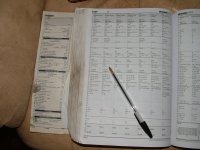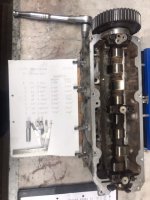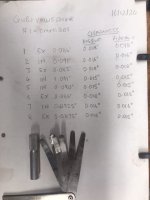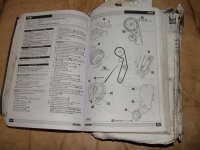Hi BugsyMike
Ah the joys of buckets and shims! Figuring out which shims would swap to other valves was like one of those 1960s IQ tests where Jane is sitting next to Paul, Paul then moves 2 to the left of Jim, Peter goes to the loo, so who is sitting next to Colin?.... I'm sure you remember them. Great fun with the 16 valvers, used to put them all in Excel and move them around on the computer before doing it for real and still getting it wrong.
2.8 Capri - Heron heads with combustion chambers in the pistons - Bell recons piston crown temperatures get too high, and combustion is terrible so stock piston failure is endemic even normally aspirated. Throw in a turbo and its going to make a bad situation worse. I guess the Mahle pistons were forged and lower CR which got round the design shortcomings. Nice work in sorting something that the guys at Aston Martin didn't.
Yes I remember 5 star. When TEL got banned I was running a little 160 Honda with iron skull heads that soon succumbed to chronic valve seat recession. Ran another similarly equipped early Honda on Avgas 100LL split with Super which had about 2x the TEL of leaded 4 star. Used to rock up at the local airstrip and fill jerry cans until the spoilsports at customs put a stop to it. Happy days...
Giving away my age but Excel hadn't been invented then, it was around 1984 roughly from memory, so it was a case of measuring existing clearances if lucky and then working out what shims required.
When I came to the Tickford Capri first, it was a regular customer who used to run a chipped XR3i before that. The garage owner friend of his who sold him it had fitted several pistons at different times and when I got to it I found all sorts of damage including where they had hammered piston up from the bottom leaving screwdriver marks and other bodges.
I did an initial compression test and got 180psi on a few and the rest were zero from damage, so I did a total rebuild and got crank grind and rebore, but I always rebuild myself as I never trusted machine shops, so I knew bearing caps oiled and fitted with oil ways in correct position, piston ring gaps checked and well oiled pistons fitted with ring gaps spaced equally etc. checked block and heads were flat and no damage, correctly torqued etc.The way it was taught to me as an apprentice.
After fitting the new Mahle pistons I did a compression test and got a good even 150psi across all six.
At the time the customer told me there was only 100 ever made and his was one of the last 50 I think, so quite rare even then.
When I used to race Class 4 karts with Villiers 197cc engines around 1969 we always used Esso 5 star petrol when competing as reckoned to be the best. Yes engines love Tetra Ethyl Lead and when they went to unleaded old cars really had an issue.
I have mentioned on Forum before I bought an old cabin cruiser with a V6 Volvo Penta 150Hp petrol engine which was knackered from standing since 1982 roughly and fitted a Fiat Ducato Maxi 2.8 122Hp engine in which I tweaked to almost the same performance I got 26 knots and 4 gallons to the hour on diesel compared with the original when new which did 30 knots and 10 gallons to the hour on 5 Star petrol.
However the point was the old fuel tank which I replaced was full of roughly 25 year old 5 Star petrol, after filtering the rust and water out I put it in an old Fiat Uno I had and the increase in performance was really noticeable without doing anything different.

I had a friend who was foreman of the local Honda Motorcycle Dealers and any old English bikes I got offered first refusal when they came in part exchange, many of them were iron heads although I seem to recall the £25 Triumph 21 350cc was alloy.
In those days people were buying Honda Dreams and Super Dreams. Happy days when I was single and my pockets did jingle.






